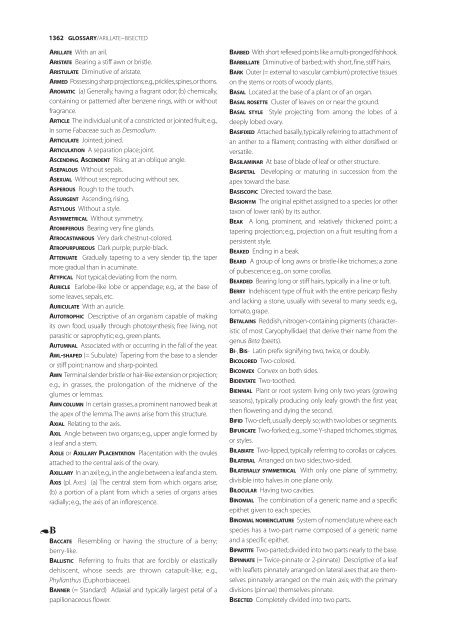Appendices & Glossary - Botanical Research Institute of Texas
Appendices & Glossary - Botanical Research Institute of Texas
Appendices & Glossary - Botanical Research Institute of Texas
You also want an ePaper? Increase the reach of your titles
YUMPU automatically turns print PDFs into web optimized ePapers that Google loves.
1362 GLOSSARY/ARILLATE–BISECTED<br />
ARILLATE With an aril.<br />
ARISTATE Bearing a stiff awn or bristle.<br />
ARISTULATE Diminutive <strong>of</strong> aristate.<br />
ARMED Possessing sharp projections;e.g.,prickles,spines,or thorns.<br />
AROMATIC (a) Generally, having a fragrant odor; (b) chemically,<br />
containing or patterned after benzene rings, with or without<br />
fragrance.<br />
ARTICLE The individual unit <strong>of</strong> a constricted or jointed fruit;e.g.,<br />
in some Fabaceae such as Desmodium.<br />
ARTICULATE Jointed; joined.<br />
ARTICULATION A separation place; joint.<br />
ASCENDING, ASCENDENT Rising at an oblique angle.<br />
ASEPALOUS Without sepals.<br />
ASEXUAL Without sex; reproducing without sex.<br />
ASPEROUS Rough to the touch.<br />
ASSURGENT Ascending, rising.<br />
ASTYLOUS Without a style.<br />
ASYMMETRICAL Without symmetry.<br />
ATOMIFEROUS Bearing very fine glands.<br />
ATROCASTANEOUS Very dark chestnut-colored.<br />
ATROPURPUREOUS Dark purple; purple-black.<br />
ATTENUATE Gradually tapering to a very slender tip, the taper<br />
more gradual than in acuminate.<br />
ATYPICAL Not typical; deviating from the norm.<br />
AURICLE Earlobe-like lobe or appendage; e.g., at the base <strong>of</strong><br />
some leaves, sepals, etc.<br />
AURICULATE With an auricle.<br />
AUTOTROPHIC Descriptive <strong>of</strong> an organism capable <strong>of</strong> making<br />
its own food, usually through photosynthesis; free living, not<br />
parasitic or saprophytic; e.g.,green plants.<br />
AUTUMNAL Associated with or occurring in the fall <strong>of</strong> the year.<br />
AWL-SHAPED (= Subulate) Tapering from the base to a slender<br />
or stiff point; narrow and sharp-pointed.<br />
AWN Terminal slender bristle or hair-like extension or projection;<br />
e.g., in grasses, the prolongation <strong>of</strong> the midnerve <strong>of</strong> the<br />
glumes or lemmas.<br />
AWN COLUMN In certain grasses,a prominent narrowed beak at<br />
the apex <strong>of</strong> the lemma.The awns arise from this structure.<br />
AXIAL Relating to the axis.<br />
AXIL Angle between two organs; e.g., upper angle formed by<br />
a leaf and a stem.<br />
AXILE or AXILLARY PLACENTATION Placentation with the ovules<br />
attached to the central axis <strong>of</strong> the ovary.<br />
AXILLARY In an axil;e.g.,in the angle between a leaf and a stem.<br />
AXIS (pl. AXES) (a) The central stem from which organs arise;<br />
(b) a portion <strong>of</strong> a plant from which a series <strong>of</strong> organs arises<br />
radially; e.g., the axis <strong>of</strong> an inflorescence.<br />
B<br />
A<br />
BACCATE Resembling or having the structure <strong>of</strong> a berry;<br />
berry-like.<br />
BALLISTIC Referring to fruits that are forcibly or elastically<br />
dehiscent, whose seeds are thrown catapult-like; e.g.,<br />
Phyllanthus (Euphorbiaceae).<br />
BANNER (= Standard) Adaxial and typically largest petal <strong>of</strong> a<br />
papilionaceous flower.<br />
BARBED With short reflexed points like a multi-pronged fishhook.<br />
BARBELLATE Diminutive <strong>of</strong> barbed; with short, fine, stiff hairs.<br />
BARK Outer (= external to vascular cambium) protective tissues<br />
on the stems or roots <strong>of</strong> woody plants.<br />
BASAL Located at the base <strong>of</strong> a plant or <strong>of</strong> an organ.<br />
BASAL ROSETTE Cluster <strong>of</strong> leaves on or near the ground.<br />
BASAL STYLE Style projecting from among the lobes <strong>of</strong> a<br />
deeply lobed ovary.<br />
BASIFIXED Attached basally,typically referring to attachment <strong>of</strong><br />
an anther to a filament; contrasting with either dorsifixed or<br />
versatile.<br />
BASILAMINAR At base <strong>of</strong> blade <strong>of</strong> leaf or other structure.<br />
BASIPETAL Developing or maturing in succession from the<br />
apex toward the base.<br />
BASISCOPIC Directed toward the base.<br />
BASIONYM The original epithet assigned to a species (or other<br />
taxon <strong>of</strong> lower rank) by its author.<br />
BEAK A long, prominent, and relatively thickened point; a<br />
tapering projection; e.g., projection on a fruit resulting from a<br />
persistent style.<br />
BEAKED Ending in a beak.<br />
BEARD A group <strong>of</strong> long awns or bristle-like trichomes; a zone<br />
<strong>of</strong> pubescence; e.g., on some corollas.<br />
BEARDED Bearing long or stiff hairs, typically in a line or tuft.<br />
BERRY Indehiscent type <strong>of</strong> fruit with the entire pericarp fleshy<br />
and lacking a stone, usually with several to many seeds; e.g.,<br />
tomato, grape.<br />
BETALAINS Reddish, nitrogen-containing pigments (characteristic<br />
<strong>of</strong> most Caryophyllidae) that derive their name from the<br />
genus Beta (beets).<br />
BI-, BIS- Latin prefix signifying two, twice, or doubly.<br />
BICOLORED Two-colored.<br />
BICONVEX Convex on both sides.<br />
BIDENTATE Two-toothed.<br />
BIENNIAL Plant or root system living only two years (growing<br />
seasons), typically producing only leafy growth the first year,<br />
then flowering and dying the second.<br />
BIFID Two-cleft,usually deeply so;with two lobes or segments.<br />
BIFURCATE Two-forked;e.g.,some Y-shaped trichomes,stigmas,<br />
or styles.<br />
BILABIATE Two-lipped, typically referring to corollas or calyces.<br />
BILATERAL Arranged on two sides; two-sided.<br />
BILATERALLY SYMMETRICAL With only one plane <strong>of</strong> symmetry;<br />
divisible into halves in one plane only.<br />
BILOCULAR Having two cavities.<br />
BINOMIAL The combination <strong>of</strong> a generic name and a specific<br />
epithet given to each species.<br />
BINOMIAL NOMENCLATURE System <strong>of</strong> nomenclature where each<br />
species has a two-part name composed <strong>of</strong> a generic name<br />
and a specific epithet.<br />
BIPARTITE Two-parted;divided into two parts nearly to the base.<br />
BIPINNATE (= Twice-pinnate or 2-pinnate) Descriptive <strong>of</strong> a leaf<br />
with leaflets pinnately arranged on lateral axes that are themselves<br />
pinnately arranged on the main axis; with the primary<br />
divisions (pinnae) themselves pinnate.<br />
BISECTED Completely divided into two parts.
















